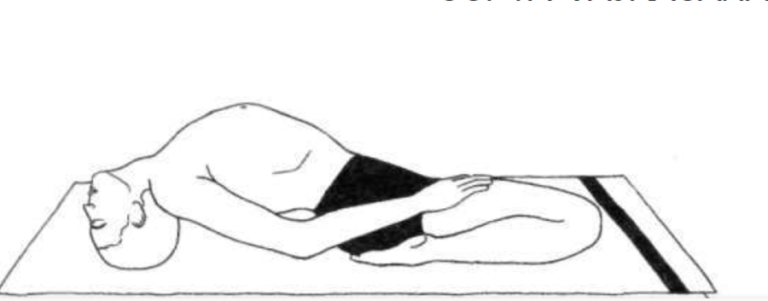Supta Vajrasana (Sleeping Thunderbolt Pose)

Description
Supta Vajrasana, also known as Sleeping Thunderbolt Pose, is a reclined yoga posture that involves bending back from a kneeling position, ultimately allowing the crown of the head to rest on the ground. This pose provides various physical and spiritual benefits, particularly focusing on the abdominal region, flexibility of the spine, and energy alignment.
Execution
- Begin in Vajrasana (Thunderbolt Pose).
- Slowly bend backward, using the right elbow and arm as support, followed by the left.
- Arch your back and bring the top of your head to the ground.
- Find balance in this position and place your hands on your thighs.
- Try to maintain knee contact with the floor; however, if needed, you can separate the knees slightly. Avoid straining muscles and ligaments by forcing the knees to the ground.
- Close your eyes and relax your body.
- Breathe deeply and slowly while in the final position.
- To return to the starting position, inhale and use the support of your elbows and arms to come back to Vajrasana.
Breathing
Practice deep and slow breathing throughout the pose.
Duration
- Beginners should start with a few seconds in the final position, gradually increasing the duration.
- For physical benefits, holding the pose for up to one minute is sufficient.
- For spiritual purposes, longer durations are recommended.
Awareness
- Physical: Focus on the crown of the head, neck, lower back, abdomen, or your breath.
- Spiritual: Direct your awareness to Swadhisthana, Anahata, or Vishuddhi Chakra.
Sequence
Follow Supta Vajrasana with a forward bending asana. Shashankasana (Hare Pose) is a suitable counterpose that can be performed directly from Vajrasana without unnecessary body movement.
Contra-indications
People with neck issues, sciatica, slipped discs, sacral ailments, or knee complaints should avoid practicing this asana.
Practice Note
- When exiting the final position, avoid straightening the legs first to prevent potential knee joint strain. Return to Vajrasana first and then extend the legs.
Variation
A variation involves placing the back of the head on the floor instead of the top. Hands can be joined under the head or arms folded above the head for comfort. Try to keep the knees on the floor while relaxing and breathing deeply.
Contra-indications
- “Supta” means sleeping, and “Vajra” refers to the energy pathway connecting sexual organs to the brain in Sanskrit
